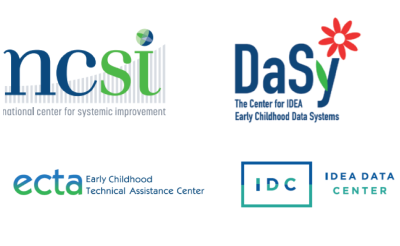
Resource Library
Guides. Briefs. Toolkits. Quick reference information. IDC and its partners created these data quality resources to help states better prepare to address their existing or emerging IDEA data quality needs. Use our search and filtering tools to navigate the library.
Resources 1 - 7 of 10
Format: Guides and Briefs
IDEA Section 618 Public Reporting Data Element Checklist – Part BThis interactive checklist helps states meet IDEA Section 618 public reporting requirements. The checklist also has an archiving function to document the posting process for later reference.
Format: Guides and Briefs
Unpacking and Understanding Part B SPP/APR Indicator 3DThe purpose of this resource is to unpack Part B SPP/APR Indicator 3D to better understand how to use Indicator 3D results to improve outcomes for all children with IEPs. This resource guides the reader through Indicator 3D, including how to calculate it; information on the setting/resetting of its baselines and targets; and considerations when analyzing, reporting, and using Indicator 3D data. As an aid to deepen learning, this resource includes examples with fictitious data.
Format: Guides and Briefs
State Determinations of Local Education Agency (LEA) PerformanceThis resource provides a summary of findings from 28 states’ publicly available LEA determinations processes. States can use this resource to learn more about the data elements, calculation methodologies, and determination category criteria these 28 states used for making LEA determinations. This information can be particularly valuable for those states considering revisions and updates to their own LEA determinations processes.
Format: Guides and Briefs
Success Gaps Rubric: Addressing Equity, Inclusion, and OpportunityThis rubric allows a team of users from a district or school to systematically examine the root causes of success gaps among groups of students by focusing on equity, inclusion, and opportunity. The recently updated rubric now includes considerations for children as young as preschool age. A complementary white paper provided the research-based background that supported development of the rubric.
Format: Guides and Briefs
A State Guide on Identifying, Correcting, and Reporting Noncompliance with IDEA RequirementsThe Individuals with Disabilities Education Act (IDEA) requires states to monitor and enforce IDEA Part C and Part B requirements, with a primary focus on those requirements that are most closely related to improving results and functional outcomes for infants, toddlers, and children with disabilities. To support states to carry out these monitoring responsibilities, A State Guide on Identifying, Correcting, and Reporting Noncompliance with IDEA Requirements describes the IDEA requirements related to identifying noncompliance, making findings of noncompliance, correcting and verifying correction of noncompliance, and federal reporting on compliance and correction of noncompliance in the state’s SPP/APR. This guide is based on the Office of Special Education Programs (OSEP) Memo 09-02: Reporting on Correction of Noncompliance in the Annual Performance Report Required under Sections 616 and 642 of the Individuals with Disabilities Education Act and the OSEP Frequently Asked Questions on Identifying and Correcting Noncompliance and Reporting on Correction in the SPP/APR.
This companion resource to A State Guide on Identifying, Correcting, and Reporting Noncompliance with IDEA Requirements summarizes the responsibilities of local early intervention programs or Local Education Agency, state Lead Agency or State Educational Agency and data that needs to be reported to OSEP on compliance, correction of noncompliance and verification of correction for SPP/APR indicators.
Format: Guides and Briefs
Graduation Rate and Dropout Rate: Indicators 1 and 2 Measurement Changes From FFY 2019 to FFY 2020–2025This resource focuses on recent changes in the data source and measurement of Part B Indicators 1 and 2. The resource specifically addresses the treatment of “alternate diploma” in the new calculation. In FFY 2019, the calculation of graduation rate included students receiving an alternate diploma in the numerator. For FFY 2020–2025 the calculation of graduation rate includes students receiving an alternate diploma in the denominator. The calculation for Indicator 2 remains similar from FFY 2019 to FFY 2020–2025; however, it explicitly adds students receiving an alternate diploma in the denominator.
Format: Guides and Briefs
The Assessment Data Journey: Are We There Yet?Data for Part B Indicator 3 follow a long and complicated process that begins when a student is registered as a test taker in a state assessment system and ends with public reporting via the SPP/APR. Multiple factors are involved in this process, and regular and ongoing communication and collaboration among the various people involved can make this process easier. This suite of four resources can help states with the work. The interactive infographic provides general information about the process for a typical state.








